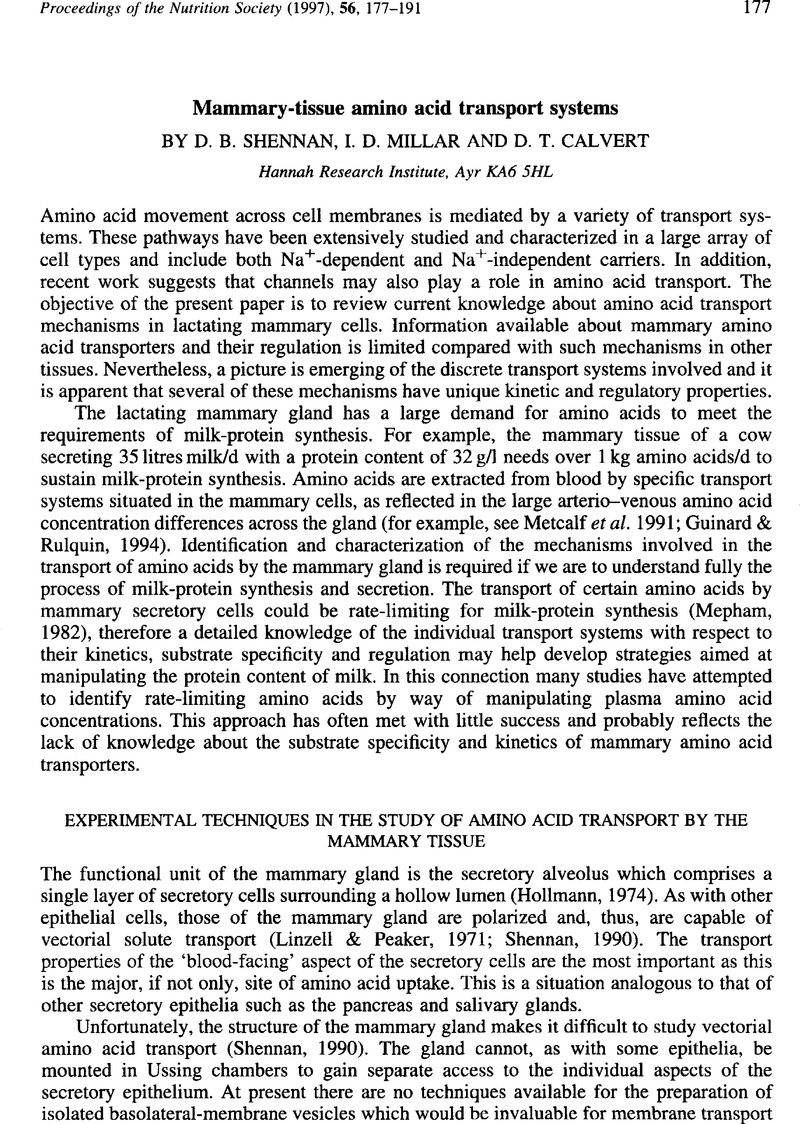Crossref Citations
This article has been cited by the following publications. This list is generated based on data provided by Crossref.
Shennan, D.B.
Grant, A.
Ramsay, R.R.
Burns, C.
and
Zammit, V.A.
1998.
Characteristics of L-carnitine transport by lactating rat mammary tissue.
Biochimica et Biophysica Acta (BBA) - Lipids and Lipid Metabolism,
Vol. 1393,
Issue. 1,
p.
49.
Martínez-López, Itziar
García, Concha
Barber, Teresa
Viña, Juan R.
and
Miralles, Vicente J.
1998.
The L-glutamate transporters GLAST (EAAT1) and GLT-1 (EAAT2): Expression and regulation in rat lactating mammary gland.
Molecular Membrane Biology,
Vol. 15,
Issue. 4,
p.
237.
Millar, I.D
and
Shennan, D.B
1999.
The regulation of Na+-dependent anionic amino acid transport by the rat mammary gland.
Biochimica et Biophysica Acta (BBA) - Biomembranes,
Vol. 1421,
Issue. 2,
p.
340.
Grant, A.C.G
Gow, I.F
Zammit, V.A
and
Shennan, D.B
2000.
Regulation of protein synthesis in lactating rat mammary tissue by cell volume.
Biochimica et Biophysica Acta (BBA) - General Subjects,
Vol. 1475,
Issue. 1,
p.
39.
Bequette, B.J.
Hanigan, M.D.
Calder, A.G.
Reynolds, C.K.
Lobley, G.E.
and
MacRae, J.C.
2000.
Amino Acid Exchange by the Mammary Gland of Lactating Goats when Histidine Limits Milk Production.
Journal of Dairy Science,
Vol. 83,
Issue. 4,
p.
765.
MacRae, J.C.
Bequette, B.J.
and
Crompton, L.A.
2000.
Synthesis of milk protein and opportunities for nutritional manipulation.
BSAP Occasional Publication,
Vol. 25,
Issue. ,
p.
179.
Mackle, T.R.
Dwyer, D.A.
Ingvartsen, K.L.
Chouinard, P.Y.
Ross, D.A.
and
Bauman, D.E.
2000.
Effects of Insulin and Postruminal Supply of Protein on Use of Amino Acids by the Mammary Gland for Milk Protein Synthesis.
Journal of Dairy Science,
Vol. 83,
Issue. 1,
p.
93.
Shennan, D. B.
and
Peaker, M.
2000.
Transport of Milk Constituents by the Mammary Gland.
Physiological Reviews,
Vol. 80,
Issue. 3,
p.
925.
Tovar, Armando R.
Becerril, Enrique
Hernández-Pando, Rogelio
López, Gabriel
Suryawan, Agus
Desantiago, Soledad
Hutson, Susan M.
and
Torres, Nimbe
2001.
Localization and expression of BCAT during pregnancy and lactation in the rat mammary gland.
American Journal of Physiology-Endocrinology and Metabolism,
Vol. 280,
Issue. 3,
p.
E480.
Bryson, J.M.
Jackson, S.C.
Wang, H.
and
Hurley, W.L.
2001.
Cellular uptake of taurine by lactating porcine mammary tissue.
Comparative Biochemistry and Physiology Part B: Biochemistry and Molecular Biology,
Vol. 128,
Issue. 4,
p.
667.
Trottier, Nathalie L.
Guan, Xinfu
Ku, Pao K.
Bequette, Brian J.
Calder, Graham
and
Ames, Kent N.
2002.
Amino Acid Availability Affects Amino Acid Flux and Protein Metabolism in the Porcine Mammary Gland.
The Journal of Nutrition,
Vol. 132,
Issue. 6,
p.
1224.
Jones, G.M.
Edwards, S.A.
Sinclair, A.G.
Gebbie, F.E.
Rooke, J.A.
Jagger, S.
and
Hoste, S.
2002.
The effect of maize starch or soya-bean oil as energy sources in lactation on sow and piglet performance in association with sow metabolic state around peak lactation.
Animal Science,
Vol. 75,
Issue. 1,
p.
57.
McManaman, James L
and
Neville, Margaret C
2003.
Mammary physiology and milk secretion.
Advanced Drug Delivery Reviews,
Vol. 55,
Issue. 5,
p.
629.
Vilotte, J. L.
Whitelaw, C. B. A.
Ollivier-Bousquet, M.
and
Shennan, D. B.
2003.
Advanced Dairy Chemistry—1 Proteins.
p.
699.
Guan, X.
Pettigrew, J. E.
Ku, P. K.
Ames, N. K.
Bequette, B. J.
and
Trottier, N. L.
2004.
Dietary protein concentration affects plasma arteriovenous difference of amino acids across the porcine mammary gland1.
Journal of Animal Science,
Vol. 82,
Issue. 10,
p.
2953.
López, Adriana
Torres, Nimbe
Ortiz, Victor
Alemán, Gabriela
Hernández-Pando, Rogelio
and
Tovar, Armando R.
2006.
Characterization and regulation of the gene expression of amino acid transport system A (SNAT2) in rat mammary gland.
American Journal of Physiology-Endocrinology and Metabolism,
Vol. 291,
Issue. 5,
p.
E1059.
Farmer, Chantal
Guan, Xinfu
and
Trottier, Nathalie L.
2008.
Mammary arteriovenous differences of glucose, insulin, prolactin and IGF-I in lactating sows under different protein intake levels.
Domestic Animal Endocrinology,
Vol. 34,
Issue. 1,
p.
54.
HEPBURN, N. L.
KNIGHT, C. H.
WILDE, C. J.
HENDRY, K. A. K.
and
GALBRAITH, H.
2008.
L-methionine uptake, incorporation and effects on proliferative activity and protein synthesis in bovine claw tissue explants in vitro.
The Journal of Agricultural Science,
Vol. 146,
Issue. 1,
p.
103.
Laspiur, Juliana Pérez
Burton, Jeanne L.
Weber, Patty S.D.
Moore, Julie
Kirkwood, Roy N.
and
Trottier, Nathalie L.
2009.
Dietary Protein Intake and Stage of Lactation Differentially Modulate Amino Acid Transporter mRNA Abundance in Porcine Mammary Tissue.
The Journal of Nutrition,
Vol. 139,
Issue. 9,
p.
1677.
VOLPE, V.
CANT, J. P.
BOSTON, R. C.
SUSMEL, P.
and
MOATE, P.
2010.
Development of a dynamic mathematical model for investigating mammary gland metabolism in lactating cows.
The Journal of Agricultural Science,
Vol. 148,
Issue. 1,
p.
31.



